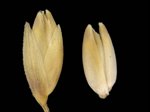
T. biflora spikelets.
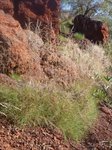
T. biflora habitat.
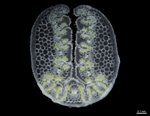
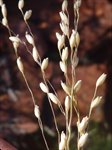
T. biflora inflorescence.
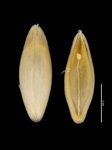
T. biflora lemmas.

T. biflora paleas.

T. biflora caryopses.

T. biflora map.
Name
Triodia biflora Lazarides
Citation
Austral. Syst. Bot. 10: 412 (1997)
Derivation
biflora — from the Latin bi-, two, and flos, flower, in reference to the two fertile flowers per spikelet.Common name
Two-flowered Spinifex
Synonyms
None
Diagnostic features
Foliage resinous; leaf sheath surfaces glabrous; leaf blades epistomatous (soft-type); spikelets with only 2 fertile florets, with a minute vestigial third floret on a long stalk that requires dissection to see; lower glume 2.5–3.5 mm long, elliptic, 3-nerved; lemmas lacking hairs, the apex entire or minutely notched, uniformly textured; lowest lemma midlobe 0.05–0.45 mm long; palea winged, glabrous; habit in gorges, below cliffs or on ironstone ridges near mountain summits.
Habitat
Occurs in gorges, below cliffs or on ironstone ridges near mountain summits
Distribution and frequency
Endemic to the Pilbara. Occurs patchily in the Central Hamersley Range, with an isolated small population at Shay Gap. Rare and highly localized in the landscape.
Similar species
Triodia biflora belongs to the Soft group, sharing the epistomatous (soft-type leaf blades) and resinous foliage. Triodia biflora is unique amongst Pilbara species in having only two fertile florets, plus a third minute vestigial floret on a long rachis (3 or more fertile florets in all other species).
Triodia biflora differs further from most other species in the Soft group by having elliptic to oblong or ovate glumes (narrowly lanceolate in all other Soft-group species except T. epactia and T. pungens).
Triodia epactia and T. pungens differ further in having longer (0.6 mm or more), acute to sharply acute lemma lobes and the lemma body hairy at least on the lower margins and midrib (lemma lobes 00.5–0.45 mm long and lemma entirely glabrous in T. biflora).Conservation status
Priority Three recommended.
Identification without florets
The combination of copious resin, epistomatous (soft-type) leaf blades and elliptic to oblong or ovate (i.e. not narrowly lanceolate) glumes is found only in T. epactia and T. pungens. Triodia biflora has shorter glumes 2.5–3.5 mm long, compared to (3)4–11 mm long in T. epactia and T. pungens.
Variation
A uniform species.
Notes
The species concept of T. biflora used here is the same as Lazarides (1997), Lazarides et al. (2005) and Ausgrass (Sharp & Simon, 2002; Simon & Alonso, 2014), which all contain full descriptions.